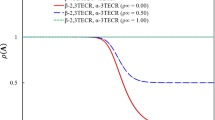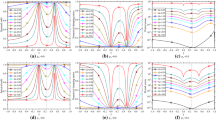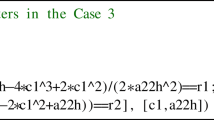Abstract
The existing three-parameter single-step time integration methods, such as the Generalized-\(\alpha \) method, improve numerical dissipation by modifying equilibrium equation at time points, which cause them to lose accuracy due to the interpolation of load vectors. Moreover, these three-parameter methods do not present an available formulation applied to a general second-order nonlinear differential equation. To solve these problems, this paper proposes an innovative three-parameter single-step method by introducing an additional variable into update equations. Although the present method is spectrally identical to the Generalized-\(\alpha \) method for undamped systems, it possesses higher accuracy since it strictly satisfies the equilibrium equation at time points, and can be readily used to solve nonlinear equations. By the analysis of accuracy, stability, numerical dissipation and dispersion, the optimal second-order implicit and explicit schemes are generated, which can maximize low-frequency accuracy when high-frequency dissipation is specified. To check the performance of the proposed method, several numerical experiments are conducted and the proposed method is compared with a few up-to-date methods.












Similar content being viewed by others
References
Newmark, N.M.: A method of computation for structural dynamics. Proc. ASCE 85, 67–94 (1959)
Wilson E.L.: A computer program for the dynamic stress analysis of underground structures. California Univ. Berkeley Structural Engineering Lab, No. SEL-68-1, 1968
Hilber, H.M., Hughes, T.J.R., Taylor, R.L.: Improved numerical dissipation for time integration algorithms in structural dynamics. Earthq. Eng. Struct. D 5, 283–292 (1977)
Wood, W.L., Bossak, M., Zienkiewicz, O.C.: An alpha modification of Newmark’s method. Int. J. Numer. Methods Eng. 15, 1562–1566 (1980)
Chung, J., Hulbert, G.: A time integration algorithm for structural dynamics with improved numerical dissipation: the generalized \(\alpha \)-method. J. Appl. Mech. 32, 371–375 (1993)
Houbolt, J.C.: A recurrence matrix solution for the dynamic response of elastic aircraft. J. Aeronaut. Sci. 17, 540–550 (1950)
Park, K.C.: An improved stiffly stable method for direct integration of nonlinear structural dynamic equation. J. Appl. Mech. 42, 464–470 (1975)
Zhai, W.M.: Two simple fast integration methods for large-scale dynamic problems in engineering. Int. J. Numer. Methods Eng. 39, 4199–4214 (1996)
Rezaiee-Pajand, M., Alamatian, J.: Implicit higher order accuracy method for numerical integration in dynamic analysis. J. Struct. Eng. ASCE 134, 973–985 (2008)
Alamatian, J., Rezaiee-Pajand, M.: Numerical time integration for dynamic analysis using a new higher order predictor-corrector method. Eng. Comput. 25, 541–568 (2008)
Zienkiewicz, O.C., Wood, W.L., Hine, N.M., et al.: A unified set of single step algorithms. Part 1: general formulation and application. Int. J. Numer. Methods Eng. 20, 1529–1552 (1984)
Tamma, K.K., Sha, D., Zhou, X.: Time discretized operators. Part 1: towards the theoretical design of a new generation of a generalized family of unconditionally stable implicit and explicit representations of arbitrary order for computational dynamics. Comput. Methods Appl. Mech. Eng. 192, 257–290 (2003)
Sha, D., Zhou, X., Tamma, K.K.: Time discretized operators. Part 2: towards the theoretical design of a new generation of a generalized family of unconditionally stable implicit and explicit representations of arbitrary order for computational dynamics. Comput. Methods Appl. Mech. Eng. 192, 291–329 (2003)
Zhou, X., Tamma, K.K.: Design, analysis, and synthesis of generalized single step single solve and optimal algorithms for structural dynamics. Int. J. Numer. Methods Eng. 59, 597–668 (2004)
Bathe, K.J., Baig, M.M.I.: On a composite implicit time integration procedure for nonlinear dynamics. Comput. Struct. 83, 2513–2524 (2005)
Noh, G., Bathe, K.J.: An explicit time integration scheme for the analysis of wave propagations. Comput. Struct. 129, 178–193 (2013)
Zhang, J., Liu, Y., Liu, D.: Accuracy of a composite implicit time integration scheme for structural dynamics. Int. J. Numer. Methods Eng. 109, 368–406 (2017)
Noh, G., Ham, S., Bathe, K.J.: Performance of an implicit time integration scheme in the analysis of wave propagations. Comput. Struct. 123, 93–105 (2013)
Klarmann, S., Wagner, W.: Enhanced studies on a composite time integration scheme in linear and non-linear dynamics. Comput. Mech. 2015, 455–468 (2015)
Chandra, Y., Zhou, Y., Stanciulescu, I., et al.: A robust composite time integration scheme for snap-through problems. Comput. Mech. 55, 1041–1056 (2015)
Wen, W.B., Wei, K., Lei, H.S., et al.: A novel sub-step composite implicit time integration scheme for structural dynamics. Comput. Struct. 182, 176–186 (2017)
Rezaiee-Pajand, M., Sarafrazi, S.R.: A mixed and multi-step higher-order implicit time integration family. J. Mech. Eng. Sci. 224, 2097–2108 (2010)
Xing, Y., Guo, J.: Differential quadrature time element method for structural dynamics. Acta Mech. Sin. 28, 782–792 (2012)
Xing, Y., Qin, M., Guo, J.: A time finite element method based on the differential quadrature rule and Hamilton’s variational principle. Appl. Sci. 7, 138 (2017)
Qin, M., Xing, Y., Guo, J.: An improved differential quadrature time element method. Appl. Sci. 7, 471 (2017)
Wen, W.B., Luo, S.M., Jian, K.L.: A novel time integration method for structural dynamics utilizing uniform quintic B-spline functions. Arch. Appl. Mech. 85, 1743–1759 (2015)
Shojaee, S., Rostami, S., Abbasi, A.: An unconditionally stable implicit time integration algorithm: modified quartic B-spline method. Comput. Struct. 153, 98–111 (2015)
Tamma, K.K., Har, J., Zhou, X.M., et al.: An overview and recent advances in vector and scalar formalisms: space/Time discretization in computational dynamics-A unified approach. Arch. Comput. Methods E. 18, 119–283 (2011)
Shao, H.P., Cai, C.W.: The direct integration three-parameter optimal schemes for structural dynamics. In: Proceeding of the International Conference: Machine Dynamics and Engineering Applications, Xi’an, 1988, pp. 16–20
Lax, P.D., Richmyer, R.D.: Survey of the stability of linear limit difference equations. Commun. Pure Appl. Math. 9, 267–293 (1956)
Bathe, K.J., Wilson, E.L.: Stability and accuracy analysis of direct direction methods. Earthq. Eng. Struct. D 1, 283–291 (1973)
Dahlquist, G.: A special stability problem for linear multistep methods. BIT 3, 27–43 (1963)
Hulbert, G.M., Chung, J.: Explicit time integration algorithms for structural dynamics with optimal numerical dissipation. Comput. Methods Appl. Mech. Eng. J. 137, 175–188 (1996)
Gobat, J.I., Grosenbaugh, M.A.: Application of the generalized-\(\alpha \) method to the time integration of the cable dynamics equations. Comput. Methods Appl. Mech. Eng. J. 190, 4817–4829 (2001)
Acknowledgements
This work was supported by the National Natural Science Foundation of China (11672019, 11372021, and 37686003).
Author information
Authors and Affiliations
Corresponding author
Rights and permissions
About this article
Cite this article
Zhang, H., Xing, Y. A three-parameter single-step time integration method for structural dynamic analysis. Acta Mech. Sin. 35, 112–128 (2019). https://doi.org/10.1007/s10409-018-0775-y
Received:
Revised:
Accepted:
Published:
Issue Date:
DOI: https://doi.org/10.1007/s10409-018-0775-y




